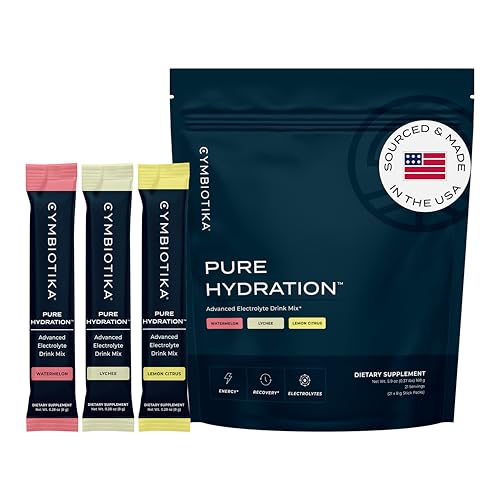
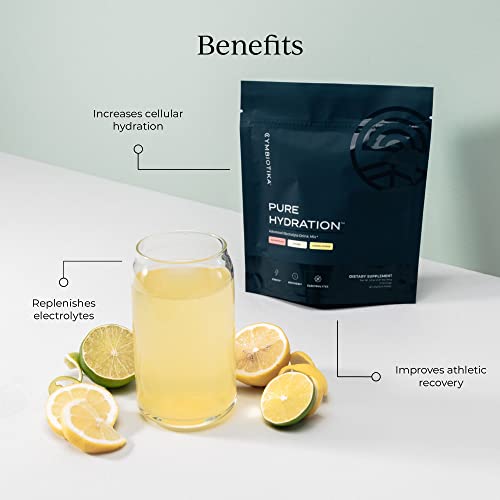
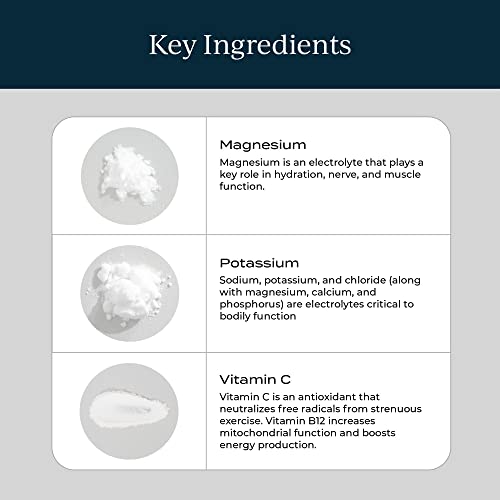
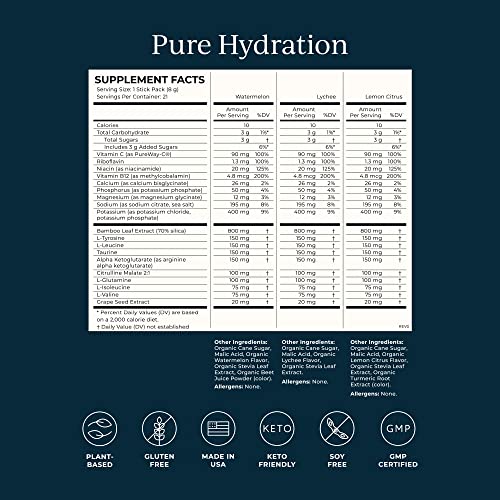

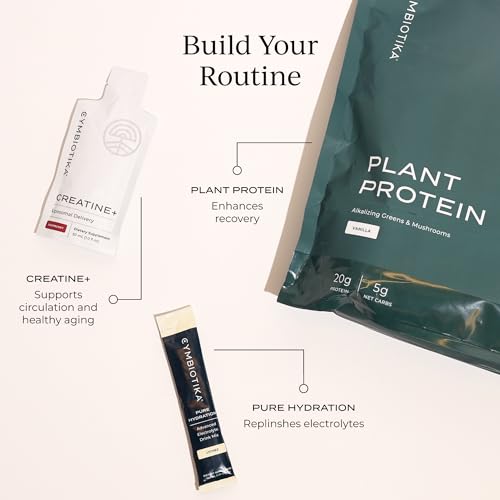
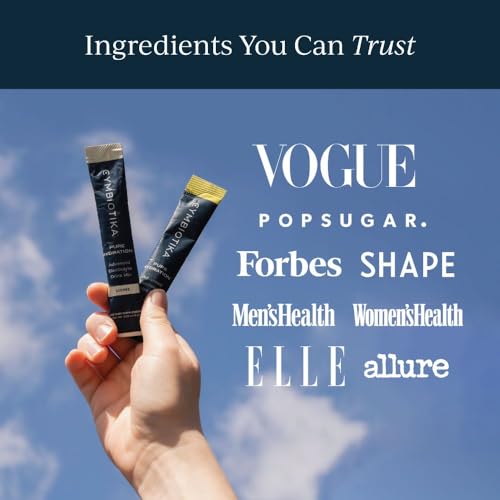


CYMBIOTIKA Pure Hydration Electrolytes Powder - Boosts Recovery, Natural Ingredients - 21 Packets


Niacinamide
Low RiskNiacinamide, also known as nicotinamide, is a form of vitamin B3 (niacin) that serves various functions in skincare and cosmetic products. It is often used for its potential benefits in improving skin texture, enhancing moisture retention, and supporting the skin's barrier function.
Sustai Insights
Niacinamide provides functional benefits such as enhancing skin hydration and improving the appearance of uneven skin tone. It is generally recognized as safe, with low concerns regarding carcinogenicity, allergies, or reproductive toxicity. However, enhanced skin absorption may pose risks for sensitive individuals. Regulatory bodies impose few restrictions on its use, and it is considered low risk overall. For safer alternatives, options like panthenol may be considered. Overall, niacinamide is a low-risk ingredient when used appropriately.
Bambusa Tuldoides (Bamboo) Leaf Extract
Low RiskBambusa tuldoides (bamboo) leaf extract is derived from the leaves of the bamboo plant. It is commonly used in cosmetic formulations for its potential soothing and antioxidant properties. The extract may also serve as a natural source of vitamins and minerals, contributing to the overall stability of products.
Sustai Insights
Bambusa tuldoides leaf extract offers functional benefits such as antioxidant properties and skin soothing effects. It is derived from a renewable resource, contributing to sustainability. Health risks are low, with minimal concerns regarding carcinogenicity, allergies, or reproductive toxicity. Environmental impact is also low, with no known pollutant or bioaccumulation risks. It is not currently subject to any regulatory restrictions. Overall, the risk level associated with this ingredient is assessed as low, making it a safe choice in formulations.
Valine
Low RiskValine is an essential amino acid that plays a critical role in protein synthesis, muscle metabolism, and energy production. It is one of the branched-chain amino acids (BCAAs) and is primarily found in protein-rich foods. Valine is important for maintaining nitrogen balance in the body.
Sustai Insights
Valine offers functional benefits such as supporting muscle recovery and energy production during exercise. It is generally recognized as safe, with low concerns regarding carcinogenicity, allergies, and reproductive toxicity. There are minimal environmental risks associated with valine, and it is not known to bioaccumulate. Regulatory bodies have not placed significant restrictions on its use, resulting in an overall low-risk assessment. Safe usage practices include adhering to recommended dietary intake levels, with alternatives such as leucine and isoleucine also available for similar benefits.
Sea Salt
Low RiskSea salt is a mixture of inorganic salts derived primarily from the evaporation of seawater. It consists mainly of sodium chloride, with minor amounts of other minerals. Sea salt is commonly used as a seasoning and preservative in food products and may also have applications in cosmetics and personal care items.
Sustai Insights
Sea salt serves as an effective flavor enhancer and preservative, contributing to the taste and shelf-life of food products. It is generally considered safe with low risk for health concerns such as cancer, allergies, and reproductive toxicity. Environmental impact is minimal, as it does not contribute significantly to pollution or bioaccumulation. Regulatory bodies, including the FDA, currently do not impose restrictions on its use. Overall, the risk level associated with sea salt is low, making it a widely accepted ingredient with no significant adverse effects reported.
Vitis Vinifera (Grape) Seed Extract
Low RiskVitis vinifera (grape) seed extract is derived from the seeds of grapes and is commonly used in cosmetic formulations for its antioxidant properties. It functions primarily as a skin-conditioning agent and is known for its potential benefits in skincare products.
Sustai Insights
Grape seed extract is valued for its antioxidant properties, which can help protect the skin from oxidative stress. It is generally regarded as safe with low concerns regarding carcinogenicity, allergies, and reproductive toxicity. Environmentally, it poses minimal risks and is not known to bioaccumulate. Regulatory bodies do not impose significant restrictions on its use. Overall, it is assessed as low risk, making it a suitable choice in cosmetic formulations. Alternatives include other plant extracts with similar benefits, such as green tea extract.
Potassium Chloride
Low RiskPotassium chloride is an inorganic salt commonly used as a potassium supplement and for its flavor-enhancing properties in food products. It serves as a mineral source and is utilized in various applications, including electrolyte balance in dietary formulations and as a partial substitute for sodium chloride.
Sustai Insights
Potassium chloride offers functional benefits as a potassium source, aiding in electrolyte balance and enhancing flavor. It is generally regarded as low risk, with minimal health concerns regarding carcinogenicity, allergies, or reproductive toxicity. Environmental impacts are also low, with no significant pollutant or bioaccumulation concerns noted. Regulatory bodies, including the FDA, do not impose restrictions on its use. Safe usage is advised to avoid excessive intake. Overall, potassium chloride is considered a safe ingredient with low risk, making it a viable option in various formulations.
Potassium Phosphate
Low RiskPotassium phosphate is an inorganic salt commonly used in food and pharmaceutical products as a buffering agent, emulsifier, and nutrient source. It aids in maintaining pH balance and stabilizing formulations.
Sustai Insights
Potassium phosphate offers functional benefits such as effective pH regulation and nutrient provision. It has a low risk of health concerns, including low allergenic potential and no known carcinogenic effects. Environmentally, it poses minimal risks, with no significant pollutant potential. Regulatory bodies have not placed restrictions on its use. Overall, the risk associated with potassium phosphate is assessed as low, making it a generally safe ingredient. Safe usage practices should still be followed, and alternatives like sodium phosphate may be considered.
Cobinamide, Cobalt Methyl Derivative, Hydroxide, Dihydrogen Phosphate (Ester), Inner Salt,3'
Low RiskCobinamide, a cobalt methyl derivative, serves primarily as a cofactor in enzymatic processes and is involved in the metabolism of certain compounds in the body. It is not currently associated with skin sensitization or common use restrictions.
Sustai Insights
Cobinamide is recognized for its role in metabolic functions and has low associated health risks, including negligible concerns regarding carcinogenicity, allergies, or reproductive toxicity. Environmentally, it poses minimal risk, lacking bioaccumulative properties or significant pollution potential. Regulatory bodies do not impose restrictions on its use, indicating a low-risk profile overall. Safe usage practices are advisable, and while alternatives are limited, seeking sustainable sourcing methods is encouraged.
Isoleucine
Low RiskIsoleucine is an essential amino acid that plays a crucial role in protein synthesis and metabolic processes. It is one of the building blocks of proteins, contributing to muscle repair and growth, and is important for immune function and energy regulation.
Sustai Insights
Isoleucine is beneficial for muscle repair and growth, making it valuable in sports nutrition. It poses low health risks, with no significant concerns related to cancer, allergies, or developmental toxicity. Environmentally, it does not contribute significantly to pollution or bioaccumulation. Regulatory bodies, including the FDA, do not impose restrictions on its use. Overall, the ingredient is assessed as low risk, with no notable adverse health or environmental impacts, and no specific alternatives identified.
Riboflavin
Low RiskRiboflavin, also known as Vitamin B2, is a water-soluble vitamin essential for energy production and cellular function. It plays a critical role in the metabolism of fats, carbohydrates, and proteins, and is commonly used as a dietary supplement and food additive for its color and nutritional benefits.
Sustai Insights
Riboflavin offers functional benefits, including its role in energy metabolism and as a food colorant. It is generally recognized as safe with low risk for allergies, carcinogenicity, and reproductive toxicity. However, excessive intake can lead to minor side effects such as yellow urine. Environmentally, riboflavin poses low pollutant potential and is not bioaccumulative. Regulatory bodies like the FDA have approved its use, establishing a low risk profile overall. Recommended usage levels are safe, and alternatives include other B vitamins, ensuring a balanced intake.
Taurine
Low RiskTaurine is a naturally occurring amino acid primarily found in the brain, heart, and muscles. It plays a crucial role in various physiological processes, including bile salt formation, osmoregulation, and membrane stabilization. Taurine is commonly used in dietary supplements and energy drinks due to its purported benefits in enhancing athletic performance and cognitive function.
Sustai Insights
Taurine exhibits functional benefits such as supporting cardiovascular health and potentially enhancing exercise performance. It poses low health risks, with no significant concerns regarding carcinogenicity, allergies, or reproductive toxicity. Environmentally, taurine is not associated with pollution or bioaccumulation. Regulatory bodies have not issued specific warnings or restrictions. Overall, taurine presents a low-risk profile, making it a relatively safe ingredient in various applications. Safe usage practices should be followed, and alternatives like other amino acids can be considered for specific needs.
Phosphoric Acid, Monopotassium Salt
Low RiskPhosphoric acid, monopotassium salt is a potassium salt of phosphoric acid, commonly used in food and beverage applications as a flavoring agent and acidity regulator. Its primary function is to provide tartness and enhance the flavor profile of products.
Sustai Insights
Phosphoric acid, monopotassium salt offers functional benefits as an acidity regulator and flavor enhancer in various products. It is not associated with significant health risks, with low concerns regarding carcinogenicity, allergies, and reproductive toxicity. Environmental impacts are minimal, and it is not flagged by regulatory bodies for restrictions. Overall, the ingredient is considered low risk, with no major health or environmental concerns noted.
Potassium
Low RiskPotassium is a naturally occurring mineral essential for various biological functions, including maintaining fluid balance, muscle contractions, and nerve signaling. It is commonly used in food and cosmetic products as a salt substitute and to enhance product stability.
Sustai Insights
Potassium has functional benefits such as supporting hydration and overall cellular function. It is generally recognized as safe, with low concerns regarding carcinogenicity, allergies, and reproductive toxicity. Environmental risks are minimal, as it does not significantly contribute to pollution. Regulatory bodies have not imposed restrictions on its use. Overall, potassium is assessed as low risk, with safe usage practices recommended for optimal benefits.
Ascorbic Acid (Vitamin C)
Low RiskAscorbic acid (Vitamin C) is a naturally occurring antioxidant essential for various biological functions, including collagen synthesis and immune response. It is commonly used in cosmetic and food products for its preservative properties and ability to enhance skin brightness.
Sustai Insights
Ascorbic acid provides functional benefits as an effective antioxidant and preservative, contributing to skin health and product stability. It is generally recognized as safe with low health risks, including minimal concerns for carcinogenicity and allergies. Environmentally, it poses low risks, as it is biodegradable and does not bioaccumulate. Regulatory bodies like the FDA have not imposed significant restrictions on its use. Overall, the ingredient presents a low risk, with safe usage practices ensuring consumer safety, and alternatives such as natural extracts exist for those seeking different formulations.
Sodium
Low RiskSodium is a chemical element commonly used in various products, primarily as a preservative and stabilizing agent. It is involved in numerous reactions, contributing to the overall functionality and safety of formulations.
Sustai Insights
Sodium serves as an effective preservative, helping to extend product shelf life. It is generally recognized as safe with low concerns for carcinogenicity, allergies, and reproductive toxicity. However, excessive exposure may lead to health issues like hypertension. Environmentally, sodium is considered low risk regarding pollution and bioaccumulation. Regulatory bodies have not imposed significant restrictions on its use. Overall, the risk associated with sodium is low, making it a suitable ingredient with no major health or environmental concerns.
Niacinamide
Low RiskNiacinamide, also known as nicotinamide, is a form of vitamin B3 (niacin) that serves various functions in skincare and cosmetic products. It is often used for its potential benefits in improving skin texture, enhancing moisture retention, and supporting the skin's barrier function.
Sustai Insights
Niacinamide provides functional benefits such as enhancing skin hydration and improving the appearance of uneven skin tone. It is generally recognized as safe, with low concerns regarding carcinogenicity, allergies, or reproductive toxicity. However, enhanced skin absorption may pose risks for sensitive individuals. Regulatory bodies impose few restrictions on its use, and it is considered low risk overall. For safer alternatives, options like panthenol may be considered. Overall, niacinamide is a low-risk ingredient when used appropriately.
Bambusa Tuldoides (Bamboo) Leaf Extract
Low RiskBambusa tuldoides (bamboo) leaf extract is derived from the leaves of the bamboo plant. It is commonly used in cosmetic formulations for its potential soothing and antioxidant properties. The extract may also serve as a natural source of vitamins and minerals, contributing to the overall stability of products.
Sustai Insights
Bambusa tuldoides leaf extract offers functional benefits such as antioxidant properties and skin soothing effects. It is derived from a renewable resource, contributing to sustainability. Health risks are low, with minimal concerns regarding carcinogenicity, allergies, or reproductive toxicity. Environmental impact is also low, with no known pollutant or bioaccumulation risks. It is not currently subject to any regulatory restrictions. Overall, the risk level associated with this ingredient is assessed as low, making it a safe choice in formulations.
Valine
Low RiskValine is an essential amino acid that plays a critical role in protein synthesis, muscle metabolism, and energy production. It is one of the branched-chain amino acids (BCAAs) and is primarily found in protein-rich foods. Valine is important for maintaining nitrogen balance in the body.
Sustai Insights
Valine offers functional benefits such as supporting muscle recovery and energy production during exercise. It is generally recognized as safe, with low concerns regarding carcinogenicity, allergies, and reproductive toxicity. There are minimal environmental risks associated with valine, and it is not known to bioaccumulate. Regulatory bodies have not placed significant restrictions on its use, resulting in an overall low-risk assessment. Safe usage practices include adhering to recommended dietary intake levels, with alternatives such as leucine and isoleucine also available for similar benefits.
Sea Salt
Low RiskSea salt is a mixture of inorganic salts derived primarily from the evaporation of seawater. It consists mainly of sodium chloride, with minor amounts of other minerals. Sea salt is commonly used as a seasoning and preservative in food products and may also have applications in cosmetics and personal care items.
Sustai Insights
Sea salt serves as an effective flavor enhancer and preservative, contributing to the taste and shelf-life of food products. It is generally considered safe with low risk for health concerns such as cancer, allergies, and reproductive toxicity. Environmental impact is minimal, as it does not contribute significantly to pollution or bioaccumulation. Regulatory bodies, including the FDA, currently do not impose restrictions on its use. Overall, the risk level associated with sea salt is low, making it a widely accepted ingredient with no significant adverse effects reported.
Vitis Vinifera (Grape) Seed Extract
Low RiskVitis vinifera (grape) seed extract is derived from the seeds of grapes and is commonly used in cosmetic formulations for its antioxidant properties. It functions primarily as a skin-conditioning agent and is known for its potential benefits in skincare products.
Sustai Insights
Grape seed extract is valued for its antioxidant properties, which can help protect the skin from oxidative stress. It is generally regarded as safe with low concerns regarding carcinogenicity, allergies, and reproductive toxicity. Environmentally, it poses minimal risks and is not known to bioaccumulate. Regulatory bodies do not impose significant restrictions on its use. Overall, it is assessed as low risk, making it a suitable choice in cosmetic formulations. Alternatives include other plant extracts with similar benefits, such as green tea extract.
Potassium Chloride
Low RiskPotassium chloride is an inorganic salt commonly used as a potassium supplement and for its flavor-enhancing properties in food products. It serves as a mineral source and is utilized in various applications, including electrolyte balance in dietary formulations and as a partial substitute for sodium chloride.
Sustai Insights
Potassium chloride offers functional benefits as a potassium source, aiding in electrolyte balance and enhancing flavor. It is generally regarded as low risk, with minimal health concerns regarding carcinogenicity, allergies, or reproductive toxicity. Environmental impacts are also low, with no significant pollutant or bioaccumulation concerns noted. Regulatory bodies, including the FDA, do not impose restrictions on its use. Safe usage is advised to avoid excessive intake. Overall, potassium chloride is considered a safe ingredient with low risk, making it a viable option in various formulations.
Potassium Phosphate
Low RiskPotassium phosphate is an inorganic salt commonly used in food and pharmaceutical products as a buffering agent, emulsifier, and nutrient source. It aids in maintaining pH balance and stabilizing formulations.
Sustai Insights
Potassium phosphate offers functional benefits such as effective pH regulation and nutrient provision. It has a low risk of health concerns, including low allergenic potential and no known carcinogenic effects. Environmentally, it poses minimal risks, with no significant pollutant potential. Regulatory bodies have not placed restrictions on its use. Overall, the risk associated with potassium phosphate is assessed as low, making it a generally safe ingredient. Safe usage practices should still be followed, and alternatives like sodium phosphate may be considered.
Cobinamide, Cobalt Methyl Derivative, Hydroxide, Dihydrogen Phosphate (Ester), Inner Salt,3'
Low RiskCobinamide, a cobalt methyl derivative, serves primarily as a cofactor in enzymatic processes and is involved in the metabolism of certain compounds in the body. It is not currently associated with skin sensitization or common use restrictions.
Sustai Insights
Cobinamide is recognized for its role in metabolic functions and has low associated health risks, including negligible concerns regarding carcinogenicity, allergies, or reproductive toxicity. Environmentally, it poses minimal risk, lacking bioaccumulative properties or significant pollution potential. Regulatory bodies do not impose restrictions on its use, indicating a low-risk profile overall. Safe usage practices are advisable, and while alternatives are limited, seeking sustainable sourcing methods is encouraged.
Isoleucine
Low RiskIsoleucine is an essential amino acid that plays a crucial role in protein synthesis and metabolic processes. It is one of the building blocks of proteins, contributing to muscle repair and growth, and is important for immune function and energy regulation.
Sustai Insights
Isoleucine is beneficial for muscle repair and growth, making it valuable in sports nutrition. It poses low health risks, with no significant concerns related to cancer, allergies, or developmental toxicity. Environmentally, it does not contribute significantly to pollution or bioaccumulation. Regulatory bodies, including the FDA, do not impose restrictions on its use. Overall, the ingredient is assessed as low risk, with no notable adverse health or environmental impacts, and no specific alternatives identified.
Riboflavin
Low RiskRiboflavin, also known as Vitamin B2, is a water-soluble vitamin essential for energy production and cellular function. It plays a critical role in the metabolism of fats, carbohydrates, and proteins, and is commonly used as a dietary supplement and food additive for its color and nutritional benefits.
Sustai Insights
Riboflavin offers functional benefits, including its role in energy metabolism and as a food colorant. It is generally recognized as safe with low risk for allergies, carcinogenicity, and reproductive toxicity. However, excessive intake can lead to minor side effects such as yellow urine. Environmentally, riboflavin poses low pollutant potential and is not bioaccumulative. Regulatory bodies like the FDA have approved its use, establishing a low risk profile overall. Recommended usage levels are safe, and alternatives include other B vitamins, ensuring a balanced intake.
Taurine
Low RiskTaurine is a naturally occurring amino acid primarily found in the brain, heart, and muscles. It plays a crucial role in various physiological processes, including bile salt formation, osmoregulation, and membrane stabilization. Taurine is commonly used in dietary supplements and energy drinks due to its purported benefits in enhancing athletic performance and cognitive function.
Sustai Insights
Taurine exhibits functional benefits such as supporting cardiovascular health and potentially enhancing exercise performance. It poses low health risks, with no significant concerns regarding carcinogenicity, allergies, or reproductive toxicity. Environmentally, taurine is not associated with pollution or bioaccumulation. Regulatory bodies have not issued specific warnings or restrictions. Overall, taurine presents a low-risk profile, making it a relatively safe ingredient in various applications. Safe usage practices should be followed, and alternatives like other amino acids can be considered for specific needs.
Phosphoric Acid, Monopotassium Salt
Low RiskPhosphoric acid, monopotassium salt is a potassium salt of phosphoric acid, commonly used in food and beverage applications as a flavoring agent and acidity regulator. Its primary function is to provide tartness and enhance the flavor profile of products.
Sustai Insights
Phosphoric acid, monopotassium salt offers functional benefits as an acidity regulator and flavor enhancer in various products. It is not associated with significant health risks, with low concerns regarding carcinogenicity, allergies, and reproductive toxicity. Environmental impacts are minimal, and it is not flagged by regulatory bodies for restrictions. Overall, the ingredient is considered low risk, with no major health or environmental concerns noted.
Potassium
Low RiskPotassium is a naturally occurring mineral essential for various biological functions, including maintaining fluid balance, muscle contractions, and nerve signaling. It is commonly used in food and cosmetic products as a salt substitute and to enhance product stability.
Sustai Insights
Potassium has functional benefits such as supporting hydration and overall cellular function. It is generally recognized as safe, with low concerns regarding carcinogenicity, allergies, and reproductive toxicity. Environmental risks are minimal, as it does not significantly contribute to pollution. Regulatory bodies have not imposed restrictions on its use. Overall, potassium is assessed as low risk, with safe usage practices recommended for optimal benefits.
Ascorbic Acid (Vitamin C)
Low RiskAscorbic acid (Vitamin C) is a naturally occurring antioxidant essential for various biological functions, including collagen synthesis and immune response. It is commonly used in cosmetic and food products for its preservative properties and ability to enhance skin brightness.
Sustai Insights
Ascorbic acid provides functional benefits as an effective antioxidant and preservative, contributing to skin health and product stability. It is generally recognized as safe with low health risks, including minimal concerns for carcinogenicity and allergies. Environmentally, it poses low risks, as it is biodegradable and does not bioaccumulate. Regulatory bodies like the FDA have not imposed significant restrictions on its use. Overall, the ingredient presents a low risk, with safe usage practices ensuring consumer safety, and alternatives such as natural extracts exist for those seeking different formulations.
Sodium
Low RiskSodium is a chemical element commonly used in various products, primarily as a preservative and stabilizing agent. It is involved in numerous reactions, contributing to the overall functionality and safety of formulations.
Sustai Insights
Sodium serves as an effective preservative, helping to extend product shelf life. It is generally recognized as safe with low concerns for carcinogenicity, allergies, and reproductive toxicity. However, excessive exposure may lead to health issues like hypertension. Environmentally, sodium is considered low risk regarding pollution and bioaccumulation. Regulatory bodies have not imposed significant restrictions on its use. Overall, the risk associated with sodium is low, making it a suitable ingredient with no major health or environmental concerns.
Experience ultimate hydration with CYMBIOTIKA Pure Hydration Electrolytes Powder Drink Mix. This keto-friendly superfood blend features three refreshing flavors—Lemon, Lychee, and Watermelon—making it a delicious way to replenish your body's essential electrolytes and vitamins.
- Replenishes Electrolytes: Packed with vitamins, minerals, and amino acids, this powder helps restore electrolyte balance, essential for recovery after physical activity.
- Enhances Cellular Hydration: Formulated to improve cellular hydration and athletic recovery, making it ideal for fitness enthusiasts.
- Fortified with Magnesium & Vitamin C: Supports muscle repair and boosts immune health, perfect for post-workout rejuvenation.
- Easy to Use: Simply mix one stick pack with 10-12 oz of cold water for a refreshing hydration boost anytime, anywhere.
- Natural Ingredients: Vegan, keto, and free from chemicals, this product blends scientific innovation with traditional wellness practices, ensuring a clean and sustainable option for health-conscious consumers.
Subscribe & Save with Sustai
- Best Price Guarantee: Always enjoy the lowest prices on sustainable home essentials.
- No Surprises: We’ll notify you before shipping. No hidden fees, ever.
- You’re in Charge: Change, pause, or cancel your subscription anytime with ease.
- Eco-Friendly Deliveries: Our grouped shipments mean less packaging and lower emissions.
Join us on a sustainable journey. Special offers for a limited time! Prices and promotions may change.
Recommended Products
Experience ultimate hydration with CYMBIOTIKA Pure Hydration Electrolytes Powder Drink Mix. This keto-friendly superfood blend features three refreshing flavors—Lemon, Lychee, and Watermelon—making it a delicious way to replenish your body's essential electrolytes and vitamins.
- Replenishes Electrolytes: Packed with vitamins, minerals, and amino acids, this powder helps restore electrolyte balance, essential for recovery after physical activity.
- Enhances Cellular Hydration: Formulated to improve cellular hydration and athletic recovery, making it ideal for fitness enthusiasts.
- Fortified with Magnesium & Vitamin C: Supports muscle repair and boosts immune health, perfect for post-workout rejuvenation.
- Easy to Use: Simply mix one stick pack with 10-12 oz of cold water for a refreshing hydration boost anytime, anywhere.
- Natural Ingredients: Vegan, keto, and free from chemicals, this product blends scientific innovation with traditional wellness practices, ensuring a clean and sustainable option for health-conscious consumers.

You can have at most 2 Sustainable Steals products in your cart
Customer Reviews
Customers’ View
Customers appreciate the effective hydration and clean ingredients of the Electrolyte Powder Drink Mix. Many users highlight that it mixes easily with water and provides a refreshing boost of hydration, particularly before workouts. Comments such as "the cymbiotica sticks are convenient for a quick hit of hydration" reflect this positive sentiment. Additionally, customers value the product's natural formulation, noting its inclusion of amino acids and antioxidants, making it suitable for post-workout recovery. The variety of flavors, including watermelon, lychee, and lemon, is also mentioned, although opinions on taste vary, with some finding them overly sweet. Overall, consumers find this product aligns well with their health-conscious and eco-friendly values, offering a clean hydration solution for active lifestyles.
AI-generated from the text of customer reviewsThis product has no reviews yet.




